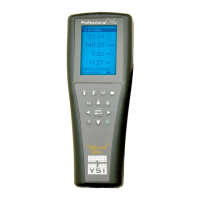UNINSTALLING DO, PH, ORP, PH/ORP AND ISE SENSORS
First, ensure that the entire sensor and cable bulkhead are clean and dry. Remove sensors upside down (facing
the ground) to help prevent water from entering the port upon removal.
Simply unscrew the sensor from the cable by holding the sensor port end of the cable (bulkhead) in one hand
and the sensor in the other hand. Twist the sensor counter-clockwise to unscrew the sensor from the port.
INSTALLING DO, PH, ORP, PH/ORP AND ISE SENSORS
First, ensure both the sensor connector and sensor port on the cable are clean and dry. If any moisture is
present, use compressed air to completely dry the connector or place directly in front of a steady flow of fresh air.
If you suspect port contamination, follow the port cleaning procedures listed under Cleaning a Sensor Port.
To connect the sensor, grasp the sensor with one hand and the sensor port end of the cable (bulkhead) in the
other. Push the sensor into the connector on the cable until it is properly seated and only one o-ring is visible.
Failure to properly seat the sensor may result in damage. Twist the sensor clockwise to engage threads and
finger tighten. Do not use a tool. This connection is waterproof. Please refer to the sensor installation sheet that
is included with each sensor for detailed instructions.
UNINSTALLING A CONDUCTIVITY/TEMPERATURE SENSOR IN A QUATRO CABLE
First, ensure that the entire sensor and cable bulkhead are clean and dry. Remove sensors upside down (facing
the ground) to help prevent water from entering the port upon removal.
Remove the conductivity/temperature sensor using the installation tool to loosen the stainless steel retaining nut.
Insert the tool into one of the holes in the stainless steel retaining nut. Next, use the installation tool to turn the
stainless steel retaining nut counter-clockwise to loosen. Do not
allow the sensor to be turned with the tool.
Turning the sensor with the tool will likely damage the sensor connector. Once the stainless steel retaining nut
has been completely loosened from the bulkhead, remove the sensor from the bulkhead by pulling the sensor
straight out of the port.
INSTALLING A CONDUCTIVITY/TEMPERATURE SENSOR IN A QUATRO CABLE
First, ensure both the sensor connector and sensor port on the cable are clean and dry. If any moisture is
present, use compressed air to completely dry the connector or place directly in front of a steady flow of fresh air.
If you suspect port contamination, follow the port cleaning procedures listed under Cleaning a Sensor Port.
1. Align the connectors of the sensor and the port. With connectors aligned, push the sensor in towards the
bulkhead until you feel the sensor seat in its port. You will experience some resistance as you push the
sensor inward, this is normal
2. Once you feel the sensor seat into the port, gently rotate the stainless steel sensor nut clockwise with your
fingers, do not
use the tool.
3. The nut must be screwed in by hand. If the nut is difficult to turn, STOP, as this may indicate cross threading.
If you feel resistance or cross threading at any point, unscrew the nut and try again until you are able to
screw the nut down completely without feeling any resistance. Damage to your cable/sensor may occur if you
force the parts together.
4. Once completely installed, the nut will seat flat against the bulkhead. At this point, use the installation tool
that was included with the sensor to turn the nut an additional ¼ to ½ turn. Do not
over tighten.
5. Please refer to the sensor installation sheet that is included with the conductivity/temperature sensor for
detailed instructions.
25

